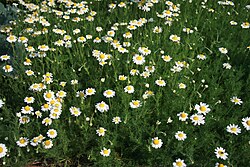Note: This is a project under development. The articles on this wiki are just being initiated and broadly incomplete. You can Help creating new pages.
Difference between revisions of "Anthemis nobilis"
(→Chemical Composition) |
|||
| Line 8: | Line 8: | ||
==Chemical Composition== | ==Chemical Composition== | ||
| − | <ref name="chemical composition"/> | + | Anthemis nobilis (Chamaemelum nobile), the so-called Roman chamomile, is a perennial herb of the Asteraceae family. It possessed antibacterial, antifungal, insecticidal, hypotensive, anti-platelet aggregation, anti-inflammatory, hypoglycaemic, antioxidant, nervous, cytotoxic, brochodilatory, endocrine and many other effects.<ref name="chemical composition"/> |
==Common names== | ==Common names== | ||
Revision as of 15:00, 26 March 2020
Anthemis nobilis is an evergreen Perennial. It grows up to 1ft tall.
Contents
[hide]- 1 Uses
- 2 Parts Used
- 3 Chemical Composition
- 4 Common names
- 5 Properties
- 6 Habit
- 7 Identification
- 8 List of Ayurvedic medicine in which the herb is used
- 9 Where to get the saplings
- 10 Mode of Propagation
- 11 How to plant/cultivate
- 12 Commonly seen growing in areas
- 13 Photo Gallery
- 14 References
- 15 External Links
Uses
Anxiety, Stress, Insomnia, Sun burn, Liver disorders, Indigestion, Peptic ulcers.
Parts Used
Chemical Composition
Anthemis nobilis (Chamaemelum nobile), the so-called Roman chamomile, is a perennial herb of the Asteraceae family. It possessed antibacterial, antifungal, insecticidal, hypotensive, anti-platelet aggregation, anti-inflammatory, hypoglycaemic, antioxidant, nervous, cytotoxic, brochodilatory, endocrine and many other effects.[1]
Common names
| Language | Common name |
|---|---|
| Kannada | |
| Hindi | |
| Malayalam | |
| Tamil | |
| Telugu | |
| Marathi | |
| Gujarathi | |
| Punjabi | |
| Kashmiri | |
| Sanskrit | |
| English |
Properties
Reference: Dravya - Substance, Rasa - Taste, Guna - Qualities, Veerya - Potency, Vipaka - Post-digesion effect, Karma - Pharmacological activity, Prabhava - Therepeutics.
Dravya
Rasa
Guna
Veerya
Vipaka
Karma
Prabhava
Habit
[[:Category:Habit - |]]
Identification
Leaf
| Kind | Shape | Feature |
|---|---|---|
Flower
| Type | Size | Color and composition | Stamen | More information |
|---|---|---|---|---|
| {{{5}}} |
Fruit
| Type | Size | Mass | Appearance | Seeds | More information |
|---|---|---|---|---|---|
Other features
List of Ayurvedic medicine in which the herb is used
Where to get the saplings
Mode of Propagation
[[:Category:Index of Plants which can be propagated by |]]
How to plant/cultivate
Tolerates most well-drained soils, preferring a dry sandy soil and a sunny position.[3]
Commonly seen growing in areas
Sandy commons, Pastures, Grassy roadsides.
Photo Gallery
References
- Jump up ↑ ["chemistry"]
- Jump up ↑ ["morphology"]
- Jump up ↑ Cultivation
External Links
- [ ]
- [ ]
- [ ]
- Ayurvedic Herbs known to be helpful to treat Anxiety
- Ayurvedic Herbs known to be helpful to treat Stress
- Ayurvedic Herbs known to be helpful to treat Insomnia
- Ayurvedic Herbs known to be helpful to treat Sun burn
- Ayurvedic Herbs known to be helpful to treat Liver disorders
- Ayurvedic Herbs known to be helpful to treat Indigestion
- Ayurvedic Herbs known to be helpful to treat Peptic ulcers
- Herbs with Stem used in medicine
- Herbs with leaves used in medicine
- Herbs with Root used in medicine
- Habit -
- Index of Plants which can be propagated by
- Herbs that are commonly seen in the region of Sandy commons
- Herbs that are commonly seen in the region of Pastures
- Herbs that are commonly seen in the region of Grassy roadsides
- Herbs
- Pages without herbs images


